![Saimir Pirgu as Idomeneo [Photo by Suzanne Schwiertz courtesy of Opernhaus Zürich]](http://www.operatoday.com/DSC_2576.gif)
04 Mar 2010
Zürich mal Zwei
Zürich Opera’s poster for their new production of Idomeneo is a knockout.
English Touring Opera are delighted to announce a season of lyric monodramas to tour nationally from October to December. The season features music for solo singer and piano by Argento, Britten, Tippett and Shostakovich with a bold and inventive approach to making opera during social distancing.
This tenth of ten Live from London concerts was in fact a recorded live performance from California. It was no less enjoyable for that, and it was also uplifting to learn that this wasn’t in fact the ‘last’ LfL event that we will be able to enjoy, courtesy of VOCES8 and their fellow vocal ensembles (more below …).
Ever since Wigmore Hall announced their superb series of autumn concerts, all streamed live and available free of charge, I’d been looking forward to this song recital by Ian Bostridge and Imogen Cooper.
The Sixteen continues its exploration of Henry Purcell’s Welcome Songs for Charles II. As with Robert King’s pioneering Purcell series begun over thirty years ago for Hyperion, Harry Christophers is recording two Welcome Songs per disc.
Although Stile Antico’s programme article for their Live from London recital introduced their selection from the many treasures of the English Renaissance in the context of the theological debates and upheavals of the Tudor and Elizabethan years, their performance was more evocative of private chamber music than of public liturgy.
In February this year, Albanian soprano Ermonela Jaho made a highly lauded debut recital at Wigmore Hall - a concert which both celebrated Opera Rara’s 50th anniversary and honoured the career of the Italian soprano Rosina Storchio (1872-1945), the star of verismo who created the title roles in Leoncavallo’s La bohème and Zazà, Mascagni’s Lodoletta and Puccini’s Madama Butterfly.
Evidently, face masks don’t stifle appreciative “Bravo!”s. And, reducing audience numbers doesn’t lower the volume of such acclamations. For, the audience at Wigmore Hall gave soprano Elizabeth Llewellyn and pianist Simon Lepper a greatly deserved warm reception and hearty response following this lunchtime recital of late-Romantic song.
Collapsology. Or, perhaps we should use the French word ‘Collapsologie’ because this is a transdisciplinary idea pretty much advocated by a series of French theorists - and apparently, mostly French theorists. It in essence focuses on the imminent collapse of modern society and all its layers - a series of escalating crises on a global scale: environmental, economic, geopolitical, governmental; the list is extensive.
For this week’s Live from London vocal recital we moved from the home of VOCES8, St Anne and St Agnes in the City of London, to Kings Place, where The Sixteen - who have been associate artists at the venue for some time - presented a programme of music and words bound together by the theme of ‘reflection’.
'Such is your divine Disposation that both you excellently understand, and royally entertaine the Exercise of Musicke.’
Amongst an avalanche of new Mahler recordings appearing at the moment (Das Lied von der Erde seems to be the most favoured, with three) this 1991 Mahler Second from the 2nd Kassel MahlerFest is one of the more interesting releases.
‘And there was war in heaven: Michael and his angels fought against the dragon; and the dragon fought and his angels, And prevailed not; neither was their place found any more in heaven … that old serpent … Satan, which deceiveth the whole world: he was cast out into the earth, and his angels were cast out with him.’
If there is one myth, it seems believed by some people today, that probably needs shattering it is that post-war recordings or performances of Wagner operas were always of exceptional quality. This 1949 Hamburg Tristan und Isolde is one of those recordings - though quite who is to blame for its many problems takes quite some unearthing.
There was never any doubt that the fifth of the twelve Met Stars Live in Concert broadcasts was going to be a palpably intense and vivid event, as well as a musically stunning and theatrically enervating experience.
‘Love’ was the theme for this Live from London performance by Apollo5. Given the complexity and diversity of that human emotion, and Apollo5’s reputation for versatility and diverse repertoire, ranging from Renaissance choral music to jazz, from contemporary classical works to popular song, it was no surprise that their programme spanned 500 years and several musical styles.
The Academy of St Martin in the Fields have titled their autumn series of eight concerts - which are taking place at 5pm and 7.30pm on two Saturdays each month at their home venue in Trafalgar Square, and being filmed for streaming the following Thursday - ‘re:connect’.
The London Symphony Orchestra opened their Autumn 2020 season with a homage to Oliver Knussen, who died at the age of 66 in July 2018. The programme traced a national musical lineage through the twentieth century, from Britten to Knussen, on to Mark-Anthony Turnage, and entwining the LSO and Rattle too.
With the Live from London digital vocal festival entering the second half of the series, the festival’s host, VOCES8, returned to their home at St Annes and St Agnes in the City of London to present a sequence of ‘Choral Dances’ - vocal music inspired by dance, embracing diverse genres from the Renaissance madrigal to swing jazz.
Just a few unison string wriggles from the opening of Mozart’s overture to Le nozze di Figaro are enough to make any opera-lover perch on the edge of their seat, in excited anticipation of the drama in music to come, so there could be no other curtain-raiser for this Gala Concert at the Royal Opera House, the latest instalment from ‘their House’ to ‘our houses’.
"Before the ending of the day, creator of all things, we pray that, with your accustomed mercy, you may watch over us."
![Saimir Pirgu as Idomeneo [Photo by Suzanne Schwiertz courtesy of Opernhaus Zürich]](http://www.operatoday.com/DSC_2576.gif)
Zürich Opera’s poster for their new production of Idomeneo is a knockout.
No fooling, the dazzling visual included a primordial mist-scape of greenish-yellows and warm golds peopled with athletically leaping dancers in primitive body suits, angrily threatening a handful of prone choristers. What volumes it spoke of the theme of other-worldly control of man’s fate. What excitement it portended for the evening to come. It was with eager anticipation that I entered the auditorium.
Would that I could say the Idomeneo I experienced lived up to its graphics.
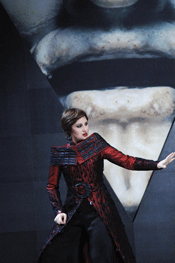 Eva Mei as Elettra
Eva Mei as Elettra
Nikolaus Harnoncourt, recently turned eighty, is a justly revered conductor, mentor, advocate, and operatic practitioner. His many accomplishments and successes are the stuff of legend, to the world in general and Zürich Opera in particular. But past triumphs be damned, we are only as good as our next show. And on this evening, while I found much to admire in his music-making, I found his staging (in tandem with his son Philipp Harnoncourt) to be dramatically unengaged and well, sometimes downright inappropriately silly.
Ma, prima la musica. The period orchestra was in a pit that was yanked up higher than I thought necessary, and while that facilitated its dramatic participation in the show (more to follow), given the Maestro’s substantial physique he loomed too large-and-in-charge as a visual distraction (sure glad I wasn’t sitting in those expensive orchestra seats behind him!). That Mr. H. knows his way around Mozart is a well-established foregone conclusion, and the meticulous attention to the smallest orchestral detail was revelatory. However, it has to be said that the sense of ensemble, especially in Act One, was not always equally attentive. On varied occasions, chorus and soloists got just behind his baton-less beat, a flaw that marred a few otherwise well-sung set pieces.
It must also be Mr. Harnoncourt’s wish that many of the pervasive recitatives be delivered as cooed, mewed, and bloodless statements. Just because a character is having a moment of introspection, shouldn’t mean that they have to lose the ‘point’ of the tone, or that they should become nigh unto inaudible. This delivery resulted in a number of turgid moments when the drama lost its forward motion, something Idomeneo can little afford. The arias were another matter entirely, lovingly shaped and propulsively led.
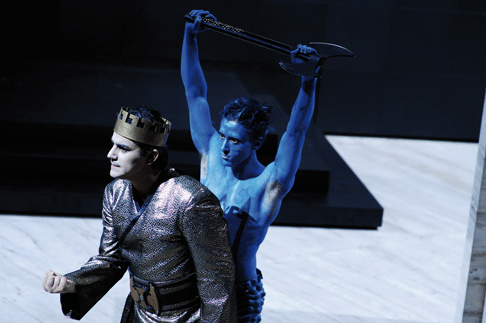 Saimir Pirgu as Idomeneo and Arman Grigoryan
Saimir Pirgu as Idomeneo and Arman Grigoryan
The most interesting musical consideration, is that Nikolaus and company here presented the ‘Munich’ version of Idomeneo, which resulted in substantial opportunities for extended dance moments, but which jettisoned the most famous aria in the piece, the eleven o’clock number D’Oreste d’Aiace. (Yes, you read it here…)
Thankfully, all the movement was exceedingly well choreographed by Heinz Spoerli. Indeed, the inventive dances were superbly executed by the talented young members of the Zürich Ballet. The extended finale gave much pleasure and would be an ideal addition to any compilation evening of any world company on any world stage. There was especially compelling use of the sinewy, inexhaustible male corps who leapt and spun, confronted and corralled the mere mortal citizenry. The threatening monster was brought on stage and eloquently danced by a muscular ballerino, all got up in briny and sparkling blue like a Vegas ‘Mister Sea.’ But say that name with a sibilant ‘s’ and you’ll have some idea of the menace he conveyed. (Nooooo, not the tour j’etee… .noooooooo… .arabesque?…arrrrrrggggggh…)
And that sort of sums up the lack of interest in dramatic tension. The Harnoncourt Boys have delivered us Idomeneo-Lite. There was some PR babble about no one yet having seen the ‘true’ presentation of this opera, and we rightly think that if Harnoncourt speaks we should listen. But the show itself was lacking in impact and emotional honesty. The entire Abraham-Isaac moment when the father is spared by the fates from sacrificing his son should be gripping, moving. Here it was glossed over as a facile plot point to be dispensed before dancing the finale.
The directors couldn’t seem to communicate if it was to be played for any comedy that could be mined, or if the relationships even mattered, or if it was guardedly anguished, or if it was realistic, or if it should resemble Bert-Brecht-on-a-Back-Burner. So they decided not to decide, and put all of it together. For an example:
As four instrumentalists stood up in the pit, and started to move around, I thought “gee, I hate that they can’t just sit there until the intermission even if they are finished for the act.” But no, the wind quartet made its way onto the stage for God’s sake, and tootled along in their black orchestra drag to Se il padre perdei. They played immaculately, but looked as uncomfortable as we were (not to mention poor Ilia). At aria’s end they simply sauntered off stage.
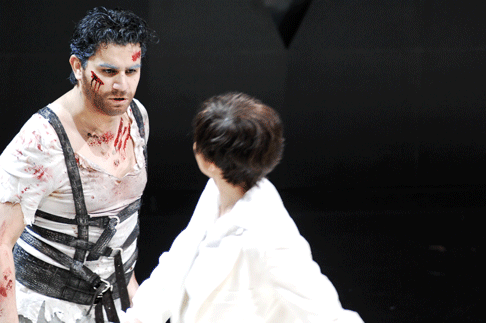 Saimir Pirgu as Idomeneo and Marie-Claude Chappuis as Idamante
Saimir Pirgu as Idomeneo and Marie-Claude Chappuis as Idamante
Elettra’s Idol mio found her entering through the pit as a fashionista with traveling case, hat, and other accoutrements. She then played the number as a clothes horse in search of a hitching post…which unfortunately included stops to tousle the hair of, and deliver Hot Mama come-hither business to several embarrassed male cellists. But even were it not for these couple of quirks, the fact is that there was no chemistry between any of the characters because none was asked of them. They were talking the story’s talk but not walking the corresponding dramatic walk. In fact the meandering blocking did more harm than good. And more is the pity, since overall the cast was highly skilled and capable of so much more.
Young (29) Saimir Pirgu was a revelation to me in the title role. Nothing about his uneven traversal of Santa Fe’s Alfredo last summer augured well for his assumption of Mozart’s most challenging tenor role. What a happy surprise then that I can report that Mr. Pirgu not only has the goods, but serves them up with relish. His passage work is clean, even fiery, his top secure and ringing, and his styling always attentive to Mozart’s wishes (save for some sanctioned crooning). There is still marginally less presence in his mid-range than in the extremes, and he is still not wholly engaged in the moment. But if Saimir can stop appearing quite so satisfied with his accomplishments as they are, and put his energies and considerable talent into where they could be, he could easily become one of the leading exponents of the role.
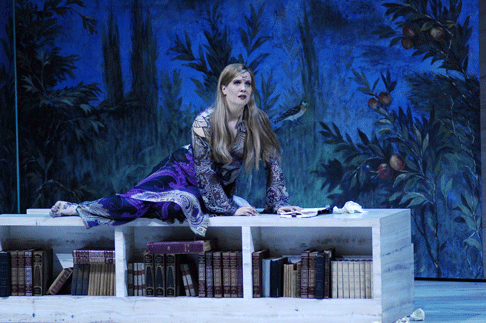 Julia Kleiter as Ilia
Julia Kleiter as Ilia
Julia Kleiter made a fine impression as Ilia, with crystal clear tone, limpid phrasing, and secure command of every facet of this complex vocal writing. I am quite sure she is capable of more spunk and sparkle, but was held back in a wilting violet, at times self-pitying character concept. Local girl Marie-Claude Chappuis was a clear audience favorite as Idamanate and she was roundly cheered. I found her voice an acquired taste, which to be fair I did actually acquire over the course of the evening. When Ms. Chappuis began I though her tone placement rather far back, not unlike Kasarova (also a local fave) in her lower register. Although a capable technician, this limited her color palette. Also, she was allowed to melodramatically ‘act’ like a male, all swagger and arm-swinging artifice, which did nothing to make her case. However, as the show wore on, and as she was able to let loose a bit more, I thought her straight-ish tone assumed more warmth and communicated considerably more character.
I first heard the young Eve Mei as a bewitching Luisa Miller some years ago. The intervening years have compromised a bit of the sheen and oomph in her lower voice. Happily, her lustrous top and reliable chest tones remain glorious, and our diva is as always a commanding stage presence. Ms. Mei’s consummate artistry was deftly deployed in negotiating the role of Elettra, and is to be credited for making a seamless impression even as she stitched together traversals through the lower middle. While we were deprived of her final aria, she nonetheless made the most of her closing outburst, vocally and dramatically, pulling down a giant black scrim and flourishing it as she exited stage left in Diva High Dudgeon.
The blind Arbace was Christoph Strehl in a successful role debut. His meandering and lengthy aria might have benefitted from a more variable color palette, but he negotiated it well, and made the most of his stage time, although hampered by a Konzept that relegated him to being a bit of a cipher, on the fringes of the story. Rudolf Schasching was imposing as the Gran Sacerdote but I wished he had sung it more and yelled it less. Mozart wrote notes for all those screamed phrases! Pavel Daniluk might have made more of an impression as La Voce had his orotund off-stage pronouncements been a teeny bit closer and/or better miked. As it was he sound like he was trapped in the men’s room. The smallest of small roles nevertheless contributed some lovely singing in the person(s) of Gloria Gottschalk and Julie Bartholomew (two Cretans) and Noel Vazquez and Flavio Mathis (two Trojans).
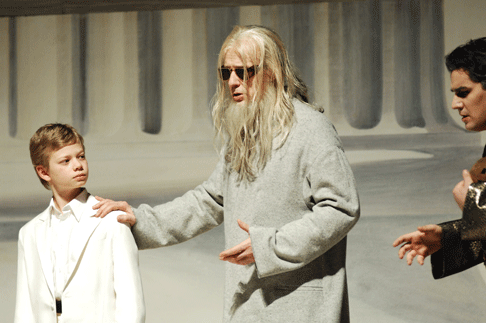 Christoph Strehl as Arbace
Christoph Strehl as Arbace
Although the costumes were all over the place in period and style, they were always handsome, often dramatically appropriate, and frequently witty. Credit the eye-catching attire to Renate Martin and Andres Donhauser, who I hope might be persuaded to re-think Ilia’s sort of paisley gown that not only seems trapped in the 60’s but does not flatter the lovely Ms. Kleiter’s coloring. The costumers did deliver a visual coup by putting the final ballet and then the returning choral forces all in white, a breath-taking evocation of a resplendent day at the beach.
Conversely, Rolf Glittenberg’s set design was curiously simplistic, the four rolling wagons looking more at home at a university opera workshop than on one of Europe’s major stages. They were decorated ‘okay’ with bits of ancient ruins on one side and flora/fauna on the other. A large black wall with a ‘V’ occupied stage right, containing a likeness of Neptune’s face. But while it swung in and out a few times (oooooh), it grew predictable and monotonous. The best technical moments actually came when the stage got cleared for the beautifully costumed dance numbers, and we could rejoice in the projected backdrops and the masterful lighting of Jürgen Hoffmann.
It was at those winning moments that Idomeneo fulfilled the great Promise of the Poster.
I am not sure if the next day’s Kőnigskinder had a good poster or not, or even if it had a poster at all. I do know that it was arguably my finest experience at Zürich Opera, and no need to beat around the bush as to why: Jonas Kaufmann and Isabel Rey must be two of the most thrilling artists to be found on the opera stage today.
The role of Humperdinck’s Goose Girl asks that its impersonator possess the youthful look of a Hannah Montana and the voice of a Sieglinde. Ms. Rey emphatically has the latter, and owing to her slight frame and inventive acting, effortlessly communicates the former. She inhabits the damaged girl’s persona like a second skin, and the hint of metal in her tone means every word is heard, every subtlety lands. She can not only vocally convey tremulous awe, deep-rooted anguish, and breathless anticipation, but can also will her well-schooled instrument to soar, tinged with unbridled joy. Masterful!
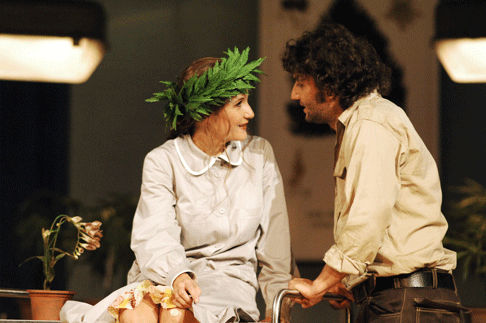 Isabel Rey as Magd and Jonas Kaufmann as Königssohn
Isabel Rey as Magd and Jonas Kaufmann as Königssohn
Mr. Kaufmann matches her for youthful demeanor, of course, and is second to none in fully embodying his characters. Jonas is born to the stage, but does not settle for generic comportment. The bewildered, well intentioned King’s Son gives him a chance to plumb depths of personality that results in a well-rounded and fascinating characterization. His burnished, at times brooding tone can smolder one minute, then ring out the next, then scale back to controlled mezza voce singing, and then execute some of the most intense high pianissimi I have heard from any tenor currently active (pace, JDF). At the peril of asking this out loud and jinxing it: Is Jonas Kaufmann the next world class star tenor we have all been waiting for? Time (and endurance) will tell but at this very moment there is no one quite like him.
But as terrific as they are singly, Rey and Kaufmann in tandem are musical magic. As they rode the whole orchestra in full-throated ecstasy my Thrill-and-Chill-Meter went off so many times that the goose bumps threatened to become a permanent condition. Later, their perfectly judged, deeply felt death scene found my eyes welling up with tears, so completely captured was I by their simplicity of purpose and their magnificent artistry. Flawless.
But this is Kőnigskinder, for God’s sake! That ‘other’ Humperdinck. The lesser one we don’t talk about, much less produce. Luckily, Zürich Opera didn’t get that memo and gifted the work with a compelling production. No pretty fairy tale setting for designer Mathis Neidhardt who instead created a dreary institution (boarding school? asylum?) with blue-ish gray walls and hanging industrial lighting fixtures, within which he suggested the opera’s bucolic Act One setting by placing us in what must be the botany room. Tagged potted plants abound on numerous rolling lab carts.
The Goose Girl is discovered alternatively day-dreaming and doing her homework, seated at one of the downstage carts, when a gaggle of young school girls burst in carrying a gaggle of paper cut-out geese on sticks like crude Japanese puppets. Are they teasing the heroine? Or playing a familiar and welcome game? The mysterious nature of the Goose Girl is captured in a portrayal that is reminiscent of the complex title character of Agnes of God. Part innocent, part child, part adult, part simpleton, and part yearning to be street-wise, this was a richly rewarding combination of subtexts, and one that Ms. Rey carried off to perfection.
When the King’s Son encountered her, he did so in the context of an intruder crawling through one of the massive windows on the side wall. Was this his first visit? Or was he simply another resident of the home returning to a recurring scenario? The vagaries of the story allow for such speculation, and the imaginative director Jens-Daniel Herzog devised richly rewarding character development and stage business. Not the least of his success was in drawing such youthfully believable, charismatic portrayals from his leading couple.
For instance, when it came time for the first kiss, the Girl was seated atop a cart, and the Son gingerly stepped up on the lower shelf causing the cart to roll slightly and break the moment. Both laughed at the mis-fired attempt. Then with locked gaze, and certain purpose, Jonas carefully stepped on again, moved to lock lips, and ‘just’ as he and Isabel tenderly kissed, he pushed off the floor with his other foot and they glided across the stage in perfect coordination with the orchestral effect. I am telling you, it was as unforgettable an image as when ET and Elliott flew across the face of the moon on the bicycle. Wow.
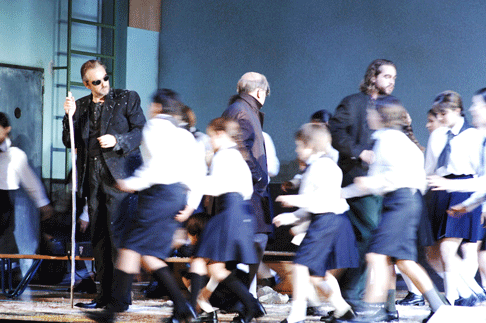 Oliver Widmer as Spielmann, Volker Vogel, Reinhard Mayr as Holzhacker and Kinder- und Jugendchor des Opernhauses Zürich
Oliver Widmer as Spielmann, Volker Vogel, Reinhard Mayr as Holzhacker and Kinder- und Jugendchor des Opernhauses Zürich
Liliana Nikiteanu’s Witch was assuredly sung with a honking big brass voice even up and down the scale; dramatically she was a school marm that combined the worst of Miss Jean Brodie and the best of Elmira Gulch. Oliver Widmer made the most of his crucial role as the (wandering) Minstrel, with a generous outpouring of stylish tone. Reinhard Mayr’s Woodcutter was a bit rough-and-tumble at first but later settled into a more vocally-controlled brash figure. The Broom-Maker was a jewel of an entertaining performance as presented by Boguslav Bidzinski, whose pleasing tenor was musically sound and deployed with theatrical flair.
In place of Act Two’s city street and (plot important) gate, the back wall rose to reveal…an identical back wall! But the room was expanded and transformed into the institution’s multi-purpose room, complete with kitchen/canteen, and a makeshift stage to accommodate some VP visitors who are coming to the place for an indeterminate ceremony. Among those dignitaries, the Head City Councilor was memorably portrayed as a frail-voiced, doddering old fool by Kai Florian Bischoff. The Landlord was competently sung by Tomasz Slawinski, and his Daughter (Anja Schlosser) was a randy Goth party girl who acted with real abandon. Her enthusiastic singing was occasionally marked by rowdy incaution. Stephanie Ritz evinced great empathy and offered plangent tones as the Broom Maker’s Daughter.
Act Three found us back in the same setting, now in ruins, with furniture over-turned and with copious snow blowing in through the open windows. It was with this act that resident designer Hoffmann’s stage lighting came into its own with splendid side and area effects. At first I thought I had visually tired of the basic box, but I have to say I cannot imagine the couple’s final moments working better any other way. Here they were, back where they began, climbing in through the window (in effect ‘breaking in’) to face their destiny in the oppressive, mysterious environment from which they had briefly ‘escaped.’
However engaging the production, or starry the singers, it all would have been for naught without a conductor able to make this massive orchestration spring to life. And here we were equally fortunate to have Ingo Metzmacher in the pit eliciting superlative playing from this talented band. His attentive sensitivity to the singers and the total understanding of the shape and pacing of the drama surely must place Maestro Metzmacher among the top opera conductors of the day. The string ensemble was especially warm and incisive, although pride of instrumental place must be given to the superb, bird-like solos from the principal flute.
With this world-class Kőnigskinder, Zürich has added another jewel to its crown.
James Sohre